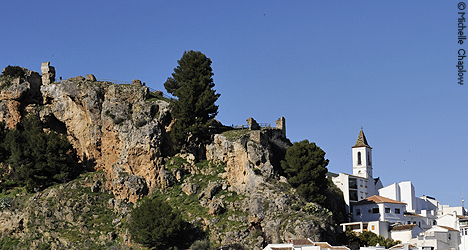
Casarabonela history
The village of today with its castle was the site of a Roman community known in Latin as Castra Vinaria. Crudely translated this means the "fortress of wine", which could have some truth. The hillsides are perfect for wine growing and the ruined castle stands on the site of a Roman fortification. The Roman community was well served by a paved road running from Málaga to Ronda, traces of which can be seen today. One stretch can be found running south towards Málaga and the other going west towards Ronda. A paved side road led south to a small Roman settlement known today as Tavilla.
The Moors remodelled both fortress and village for their own use. The Arabic invaders took the Latin name and corrupted it to Csar Bonaira. Much of the existing ruins date from the 10th century, after the Mozarabe uprising that was centred nearby at Bobastro. The castle was one of the last to fall to the Arabs in 922, when Abd Al Rahmann III used it as a base. The castle was one of strategic importance, as views of other white villages can be seen all the way down to Málaga and the coast.
It was known that the castle and by this stage a walled town was going to be a hard nut to crack. An obscure reference suggests that the Christians made an attempt to take the town as early as 1366. However under Mohammed V, based in Granada, reinforcements were obtained from North Africa. The borders of his small kingdom stabilised and the Christians remained in Zahara on the other side of Ronda for a further 120 years.
According to the chronicles, the castle was well defended by the Moors. Another Christian attempt was made on 21 June 1484 but failed when its leader Count Belalcazar was killed by an arrow outside the walls. Whether the town and castle was then besieged is not known, but the castle did not fall until 2 June 1485. After a heavy toll on both sides, the castle and town surrendered to Sancho de Rojas, in the name of the Catholic King, Don Fernando. Almost immediately martial law was enforced and Sancho de Rojas was appointed mayor.
Extensive population studies of the Moorish population between 1492 and 1500 have been conducted. What strikes any student of this period is the large population when compared to much of the surrounding area. The pueblo had 240 families when compared to Tolox, which only had 186 and Yunquera just 55. The Moorish population seems to have remained constant during this period. A church record confirms that the village had 97 cows, 66 oxen and 3,126 goats. Though the cattle numbers are low when compared to the local villages, the number of goats is double to the surrounding pueblos. This probably explains why the village was only taken after a hard fight, due to high number of defenders.
Obviously social conflict soon boiled over, as the Moors were forced to convert to Christianity. This was fuelled by the Inquisition which visited the village in 1560, and found 31 persons guilty. This was too much for the Moriscos and they openly revolted along with the whole region during Christmas 1568. This led to a two year civil war with the village only falling to Christian control again in 1570. Almost immediately any one suspected was executed or expelled, which led to the depopulation of the Moriscos.
An interesting footnote can be found in a book called Andalucia, written by Nina Epton. The mayor at the time of Carratraca was from Casarabonela, and Nina described him with delicate Moorish features and hands. She further quoted that the inhabitants are still referred to as Moriscos by the neighbouring locality. (Though the mayor was only a shepherd boy with seven months schooling under his belt, during the Civil War, he was billeted in Salvador Dali's house in Cadaques. There he made use of an extensive library and educated himself over the months he was there).
To attract settlers from Extremadura King Phillip II gave the village a charter in 1574 granting it the title of Villa or town. The charter still exists in the town hall archives.
By 1781 the population had reached 2,800 and over the next 200 years it was to peak at 5,148. However today the numbers have fallen to levels last seen back to the 18th century. This is a common theme and the mother of one of Hollywood's hottest properties, Antonio Banderas came from the pueblo.